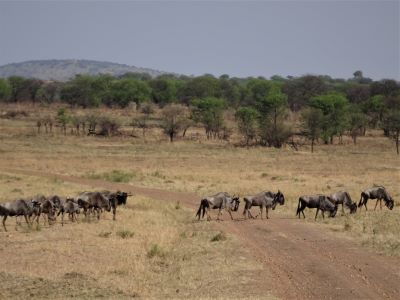
The arrival of the dry season meant that it was time for the animals of the savannah to migrate north from the Serengeti plains, across the Tanzanian border, to the cooler and greener Maasai Mara Plateau in Kenya. When the rains started up again, they would go back the same way. The wildebeest migration is one of the most spectacular phenomena in the natural world, involving millions of animals covering hundreds of miles in a relatively short time. It was for the privilege of that grand sight that I had come all the way to East Africa.
But the migration was not something that could be accurately predicted. At the end of July, when I had chosen to go, it was not certain as to whether the animals would still be in the Serengeti, or if they had already reached the Maasai Mara. On occasion, they would set off earlier than usual, which was precisely what happened that year.
When I reached the entry point into the Serengeti, the plains were already empty. In order to catch up with the moving herds, I would have had to travel a much longer distance than I originally anticipated.
I shared my concerns with Patrick, my guide, who promised that he would take me as far as I wanted. At the same time, he assured me that the Serengeti had a lot to offer, irrespective of the season. The central part of the plains, which had permanent water sources, was always full of animals. It was a great place to see, in particular, the big cats: lions, leopards, cheetahs … To give more weight to his promise, he added:
“Look, I bet you’ll see plenty of lions by tomorrow night. At least ten!”
I had a hard time believing him. All around me, as far as the eye could see, the plains were scorched and deserted. After the animals had left, the officials of the park had set fire to the dry grass to clear the ground. The Thompson gazelle—a small, long-horned gazelle, with a black, horizontal stripe above its white belly—was the only species visible on those barren lands, surviving exclusively on morning dew and remains of vegetation. This way, the delicate herbivores could enjoy their scarce food undisturbed by lions or other predators.
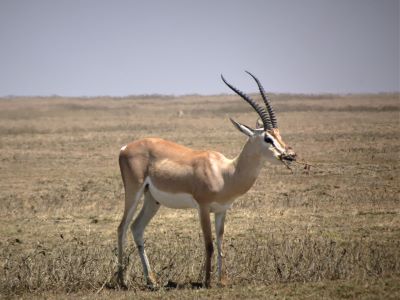
Nevertheless, after a few hours of driving on the dust road, the landscape changed radically. Finally, the splendor of the African savannah I’d been dreaming about was unfolding before my eyes. The trees came into sight, starting with umbrella-shaped acacias. Small rivers surrounded by greenery and round blocks of stone brought more life into the picture, while silhouettes of elephants and giraffes contoured in the background. The big cats didn’t take long to show up either.
First, I came across two majestic, golden-maned lions lying in the grass, right near the road. They were brothers, as Patrick explained to me.
“How do you know they are brothers?” I asked, incredulous.
“Only the young males, after they leave their pride, can be seen for a while walking two by two,” he replied. “If they weren’t related, they would tear each other apart instantly!”
Although we were only a few meters away from them, the two lions ignored us completely. The only ones who seemed to really bother them were a few elephants nearby. As they approached slowly, the big cats got up, in obvious discontent, and headed in the opposite direction, careful to keep a safe distance from the pachyderms.
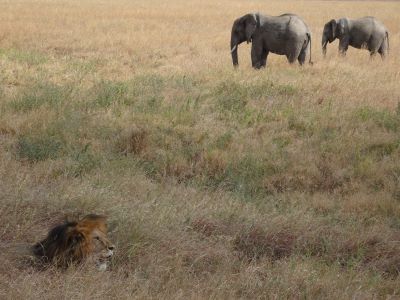
“That’s right,” Patrick said. “They wouldn’t mess with the big guys.”
I stood up to watch the elephants through the open roof of the car as my companion began his presentation:
“Apart from their strength, the elephants are extremely intelligent and well organized. They can dig for water, they can make tools, they help each other, they mourn their dead, they cry with tears … just like humans. The males live alone, while the females and calves live together in families. They connect to each other, not only as relatives, but also through friendship or adoption¾you know, orphaned babies are adopted by other females.”
Behind the elephants, a few giraffes were coming. Patrick continued:
“But the way giraffes organize themselves is not bad either. Mature giraffes also live in families. When they grow up, the young males form ‘gangs’ of bachelors. They fight by hitting each other’s necks, but this is rather for training purposes because the loser is not eliminated from the group. During the day, they are scattered, as you can see, but they never lose sight of each other. A lion wouldn’t dare attack a giraffe, unless he can sneak from behind when the giraffe is drinking water. Otherwise, a giraffe’s kick may well kill him.”
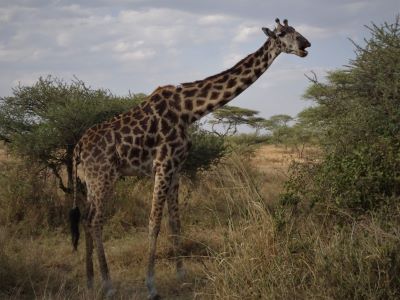
“In other words,” I provoked my interlocutor, “the lion is neither the strongest nor the most intelligent of animals. But still, he is called the king. Why?”
“Well, I guess lions are the most successful when it comes to killing other animals. That is, of course, if we don’t count the humans,” he replied, with unexpected dark humor.
Patrick confessed to me that, among all the animals in the savannah, lions were the ones that the safari customers wanted to see most. The chances of seeing a bloody scene were higher if there were lions around, he explained.
With a barely concealed smile, he then added:
“Actually, there’s another reason why lions are so admired …”
“What’s that?” I wanted to know right away.
“When they mate, they do it for four days in a row … and they only take very short breaks,” he replied, not without a trace of envy in his voice.
Further on, we passed by two sleeping lionesses. Patrick told me that lions could eat up to sixty pounds of meat at a time, after which they would do nothing but lie down for a few days or even a week, until they would get hungry again. The lionesses in question appeared to be having a deep siesta, resting in the grass with round, full bellies. We got quite close to one of them, because she was sleeping almost in the middle of the road, and the noise of the engine suddenly woke her up. She opened one eye, then jumped aside, confused. It was obvious that she felt too heavy to move, because she only took a few steps and then laid back down in the grass.
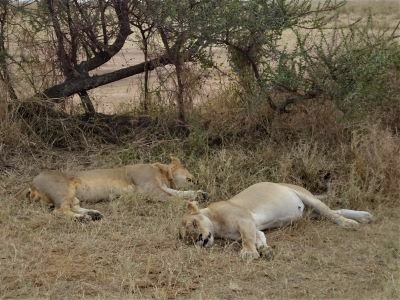
“How come the lions don’t notice us even when we’re so close?” I asked.
“Don’t get too confident! From a lion’s perspective, every living being that moves in front of their eyes is food,” Patrick smiled. “If we were on foot, we would certainly get their attention, but cars are something else. Lions do not understand that cars are full of people and that it would be very easy for them to grab someone through the open roof. For them, cars are like rolling stones, which is why they don’t pay attention to them, and they only avoid them when they are too close. Even if they smell the humans inside the cars, for them, it’s like picking up someone’s smell from a rock; it won’t make them attack the rock, so for the same reason, they won’t attack the car either.”
I found it very amusing when Patrick explained to me how lions “think,” but he was right: I had seen many cars that were not only open on top, but also on the sides, and the animals did not react to them in any way. To prove his theory, Patrick told me another story.
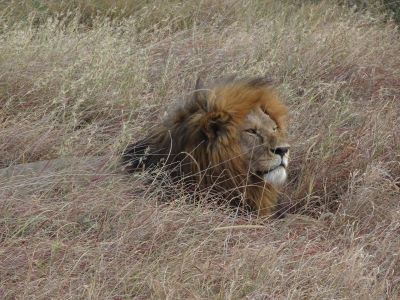
“A few years ago, when I was with some customers in this area and I stopped the car for them to take pictures, a lion suddenly jumped on the roof of the car. The top hatch was raised, but fortunately, everyone inside was seated. The lion did not realize what he was standing on. You know, they really like to climb on rocks to keep an eye on everything that moves around.”
“Wow,” I exclaimed. “I can only imagine what the passengers went through!”
“Indeed,” Patrick confirmed. “But it only lasted a few seconds. The lion didn’t even bother to look inside. As soon as I turned on the engine and moved the car, he got scared and ran like crazy.”
The guide immediately explained the situation:
“More than likely, when he realized that the ‘rock’ beneath him was moving, he thought it was an earthquake!”
On our way to the next destination, we witnessed a dramatic scene. Apparently, a group of lionesses had just attacked a wild buffalo. From what I had noticed before about buffalo herds, their defense system was well developed: the strongest males stood in front, while the oldest ones, along with the females and calves, remained sheltered in the middle of the herd. They were massive animals, and their long, powerful horns gave them a scary appearance. The fight with the lionesses could only have been fierce.
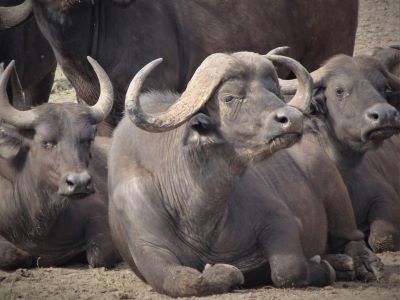
There had been victims on both sides. One of the lionesses had been crushed under the body of the buffalo that she had attacked, and remained there with a stiff paw in the air. The others were feasting on the prey’s carcass. The head of the family, a lion with a thick, dark brown mane, was sitting like a sphinx a little further away, eyes on the horizon.
“The roles are very well defined,” Patrick reminded me. “The ones who hunt are the lionesses. But if they catch something, the lion is the first who eats.”
“My, this division of tasks is not fair,” I said, faking a protest.
“Oh, but it is,” the guide assured me. “The lion’s task is to defend the territory from other males. This is the hardest and most dangerous thing to do because no animal in the savannah is a greater threat to a family of lions than a foreign lion, who would not only try to kill the head of the family, but also all the cubs – and the lionesses would not be able to stop him. So, the zebras, antelopes, and even the buffaloes, or whatever else the lionesses must hunt – are easier tasks. Now, you see, the male is on guard, watching over them while they eat.”
While we were driving away from the “action” scene, Patrick stopped again to show me a leopard on a tree branch, almost perfectly hidden in the foliage. It was quite far and challenging to watch, even with binoculars, but still, it was a sight I couldn’t forget. Leopards are magnificently beautiful creatures. There was something about them that touched me deeply, and I wondered what it was. Their solitude? Probably. Or, rather, the impression of force stemming from that solitude…
“It would be hard to think of any other animals that spend so much of their life alone. Even when they’re small, they are left alone all day by their mothers and have to wait patiently for their return from hunting…” Patrick remarked, like a follow-up to my thoughts.
Not long after, in the yellow grass, I noticed a cheetah mother with three cubs. The little ones had reached the age when they were starting to learn hunting techniques. The female, her small head raised above the grass, scanned the surroundings, ready at any moment to sprint with unparalleled speed, to catch a gazelle or chase a hyena away. But it was a real challenge for her to stay focused; the offspring were hard to control, and they were much more eager to play than to learn. Certainly, the “kindergarten” system that the lions had was much more efficient, whereby the females took turns supervising each other’s cubs.
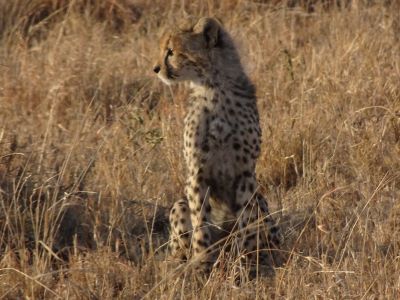
Despite the apparent cruelty or vulnerability that dominated some scenes, nature in the Serengeti was immersed in mysterious harmony. Death and life flowed naturally from one another, just as the rains followed the drought. What amounted to suffering on one level was joy on another, and so on. At the end of the row, a huge, enigmatic being seemed to be holding all those creatures in an eternal embrace …